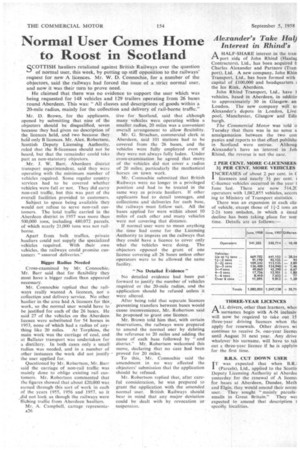Normal User Comes Home to Roost in Scotland
Page 28

If you've noticed an error in this article please click here to report it so we can fix it.
SCOTTISH hauliers retaliated against British Railways over the question of normal user, this week, by putting up still opposition to the railways' request for new A licences. Mr. W. D. Connochie, for a number of the objectors, said the railways had forced the issue of a strict normal user, and now it was their turn to prove need.
He claimed that there was no evidence to support the user which was being requested for 148 vehicles and 129 trailers operating from 26 bases round Aberdeen. This was: "All classes and descriptions of goods within .a 20-mile radius, mainly for the collection and delivery of rail-borne traffic."
Mr. D. Brown, for the applicants, opened by submitting that nine of the objectors should be disqualified; seven because they had given no description of the licences held, and two because they hell only B licences, Mr. Alex. Robertson, Scottish Deputy Licensing Authority, ruled that the II-licensees should not be heard, but that the remainder could take part as non-statutory objectors.
Mr. J. W. Barr, Aberdeen district transport superintendent, said they were operating with the minimum number of vehicles required. Some regular country services had to be covered whether vehicles were. full or not. They did carry non-rail traffic, but this was part of the overall facilities provided, to customers.
Subject to space being available they would not refuse to serve non-rail customers. The total traffic carried in the Aberdeen district in 1957 was more than 500,000 tons, including 480,072 parcels, of which nearly 21,000 tons was not rail borne.
Apart from bulk traffics, private hauliers could not supply the specialized vehicles required. With their own vehicles, the railways could promise customers "assured deliveries."
Bigger Radius Needed Cross-examined by Mr. Connochie, Mr. Barr said that for flexibility they must have a bigger radius than appeared necessary.
Mr. Connochie replied that the railways really wanted A licences, not a collection and delivery service. No other haulier in the area had A licences for this work, so the normal user would have to be justified for each of the 26 bases. He said 27 of the vehicles on the Aberdeen licence were substituted for 54 horses in 1953, none of which had a radius of any thing like 20 miles. At Torphins, the main work was the carriage of coal, and at Ballater transport was undertaken for a distillery. In both cases only a small radius was needed, and in a number of other instances the work did not justify the user applied for.
Questioned by Mr. Robertson, Mr. Barr said the carriage of non-rail traffic was mainly done to oblige existing rail customers. Mr. Robertson commented that the figures showed that about £20,000 was earned through this sort of work in each of the years 1955, 1956 and 1957, so it ,did not look as though the railways were filching traffic from Aberdeen hauliers. Mr. A. Campbell, cartage representaa26 tive for Scotland, said that although many vehicles were operating within a smaller radius, 20 miles was a convenient overall arrangement to allow flexibility.
Mr. G. Strachan, commercial clerk at Aberdeen, said 101 stations had to be covered from the 26 bases, and the vehicles were fully employed even if they were not always fully laden. Under cross-examination he agreed that many. of the vehicles did not cover a radius of 20 miles, particularly the mechanical horses on town work.
Mr. Connochie submitted that British Railways were no longer in a privileged position and had to be treated in the same way as private hauliers. If other applicants had to detail tonnages, and collections and 'deliveries for each base, the railways must follow suit. All the bases applied for were within about 10 miles of each other and many vehicles were not covering that distance.
If normal user were to mean anything the time had come for the Licensing Authority to impress on the railways that they could have a licence to cover only what the vehicles were doing. The objectors opposed the grant of one licence covering all 26 bases unless other operators were to be allowed the same facility.
"No Detailed Evidence"
No detailed evidence had been pot forward to justify the number of vehicles required or the 20-mite radius, and the application should be refused unless it were altered.
After being told that separate licences preventing transfers between bases would cause inconvenience, Mr. Robertson said he proposed to grant one licence.
Mr. Brown told him that, with certain rtservations, the railways were prepared to amend the normal user by deleting the reference to 20 miles and adding the name of each base followed by "and district." Mr. Robertson welcomed this move, declaring that no case had been proved for 20 miles.
To this, Mr. Connochie said the amendment in no way affected the objectors' submission that the application should be refused.
Mr. Robertson replied that, after careful consideration, he was prepared to grant the application with the amended normal user, British Railways should bear in mind that any major deviation could be dealt with by revocation or Suspension.




































































































